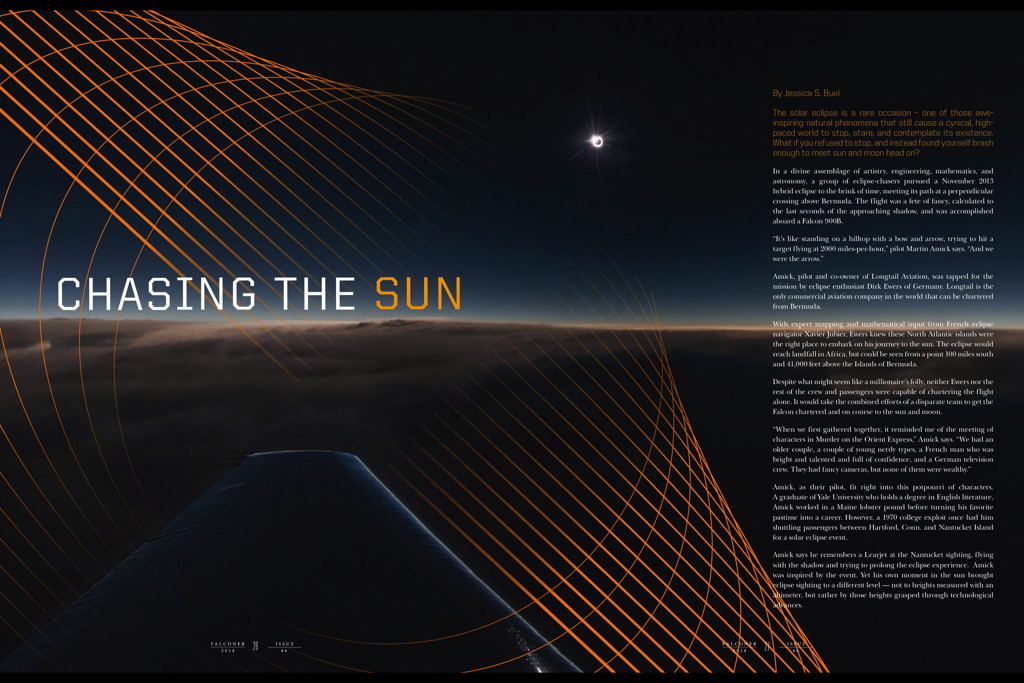
|
Total Solar Eclipse of 2013 November 3
from a private jet leaving Bermuda
|
|
|
The point of greatest eclipse (totality phase during 1 min 40 sec) lies in the Gulf of Guinea in the Atlantic Ocean. The weather prospects aren’t that good at this time of the year over the area crossed by the eclipse path, nevertheless there are quite a few interesting land-based locations, particularly at the end of the path where the Baily’s beads display will be amazing (view the simulations) and where totality will last less than twenty seconds. To observe this short total solar eclipse, I was onboard the very challenging eclipse flight from Bermuda as the expert navigator and we had a spectacular zero second grazing total solar eclipse on the edge of the stratosphere.
This hybrid solar eclipse starts as an annular and soon after becomes total when using the usual eclipse classification based on a smooth lunar limb profile. However when taking the lunar limb profile into account this does a lot of damage to the eclipse classification, so much so that the eclipse could never be seen to be annular, not even briefly. So most of the central line will only show a total eclipse, but even then a truly total eclipse will not be seen until about 11:06:45 UTC. Before then neither a total nor annular eclipse is possible as no umbral outline exists on the surface of the Earth.
You can use this solar eclipse calculator to compute the local circumstances of the eclipse, and the solar eclipse timer notifies the beginning of the various events. A time exposure calculator is there to help you choose your camera settings.
Click on thumbnails for a larger version
|
|
|
|
This hybrid eclipse manifests itself first as a broken annular at the beginning of its path and then switches very soon, a good minute later, southeast of Bermuda, to a total solar eclipse. At the transition point in space and time where such an eclipse changes from annular to total, the long, conical, apex of the lunar umbral shadow just touches the surface of the Earth for a brief instant. It could have been interesting to travel to that precise location, however intercepting the shadow cone there is next to impossible as the umbra races at speeds over 50.000 kph or 30,000 mph at this instant (11:05:20 UTC at the bottom page).
Nevertheless this eclipse flight, executed with a Dassault Falcon 900B private jet, was a milestone as intercepting the umbral shadow racing at such speeds had never been done before. The shadow was traveling at speeds in excess of 13,500 kph or 8,400 mph. The magic of the spectacle with its spendid circumferential chromospheric arc and Baily’s beads flashing all around the lunar limb for a few seconds was more than enticing for the happy few intrepid eclipse-chasers embarking on this private jet. The next similar opportunity for such an eclipse flight will be on 2031 November 14, that is the next eclipse in saros 143 but this time over the Pacific Ocean either from Hawaii at the beginning of the path or from Costa Rica at the end. The 20 April 2023 one will be easy to view from Australia and accessing both ends of the path will be expensive because of the remoteness.
My Solar Eclipse Maestro software was used in-flight to adjust in real-time the flight parameters and make sure the Falcon 900B jet hit the high-velocity target. Unfortunately a hard drive failure 24 hours before the eclipse flight prevented the use of this special version of the software, making the navigation even more challenging!
In October 2014, Dassault Falcon Jet, the American subsidiary of Dassault the French aircraft manufacturer, published a 4-page article on the eclipse flight in their Falconer magazine.
|

Pages 26 and 27 from the issue #44 of Falconer (2014)
(Falconer Online or from an iPad or iPhone)
|

Pages 28 and 29 from the issue #44 of Falconer (2014)
(Falconer Online or from an iPad or iPhone)
|
|
|
|
|
|
|


